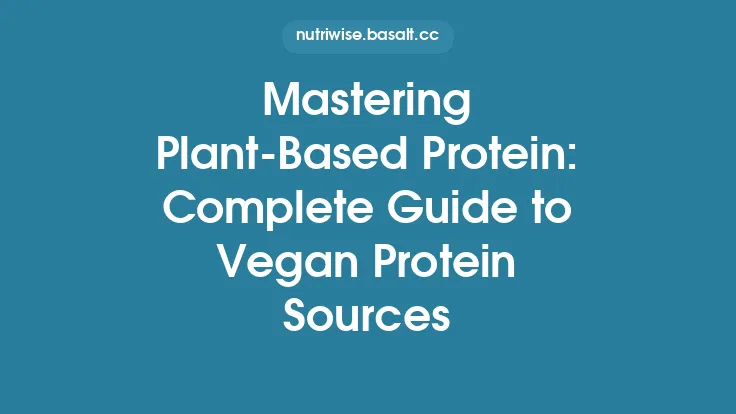Indigenous peoples across the globe have cultivated and harvested a remarkable array of plant species that serve as primary sources of dietary protein. Long before the advent of modern agronomy, these communities identified, domesticated, and refined plants whose seed, tuber, leaf, or fruit tissues contain substantial amounts of protein, often rivaling or exceeding those of widely cultivated legumes and cereals. The scientific investigation of these plant‑based protein sources reveals a complex interplay of genetics, biochemistry, and traditional processing that together determine protein quality, digestibility, and functional properties. Understanding these mechanisms not only honors the depth of Indigenous knowledge but also expands the global repository of nutritionally valuable crops.
Protein Composition of Indigenous Plants
The protein fraction in most Indigenous plant foods is distributed among storage proteins, structural proteins, and enzymatic proteins. In seeds such as the tepary bean (Phaseolus acutifolius) and the Andean lupin (Lupinus mutabilis), the dominant storage proteins are globulins (e.g., vicilin and legumin) and albumins, which together can account for 30–45 % of seed dry weight. In tuberous species like the prairie turnip (Pediomelum esculentum) and the oca (Oxalis tuberosa), storage proteins are primarily albumins and globulins localized in the parenchyma cells, contributing roughly 10–15 % of fresh weight.
Leafy greens such as amaranth (Amaranthus spp.) and the wild spinach (Chenopodium berlandieri) contain a higher proportion of structural proteins (rubisco and other chloroplast proteins), which can represent up to 20 % of leaf dry mass. These proteins are rich in essential amino acids, particularly lysine and methionine, which are often limiting in cereal grains.
Amino Acid Profiles and Complementarity
A key determinant of protein quality is the balance of essential amino acids (EAAs). Indigenous plant proteins frequently exhibit complementary amino acid patterns when combined in traditional dishes. For instance:
| Plant Species | Limiting EAA (if consumed alone) | Complementary Partner(s) |
|---|---|---|
| Tepary bean | Methionine, Cysteine | Amaranth grain, quinoa |
| Amaranth grain | Lysine (moderate) | Maize, corn (traditional) |
| Lupin seed | Tryptophan | Wild rice (Zizania spp.) |
The Protein Digestibility‑Corrected Amino Acid Score (PDCAAS) and the newer Digestible Indispensable Amino Acid Score (DIAAS) have been applied to several Indigenous species. Tepary bean typically scores 0.78–0.85 (PDCAAS) and 0.70–0.78 (DIAAS), while amaranth grain reaches 0.92 (PDCAAS) and 0.88 (DIAAS). These values reflect both the inherent amino acid composition and the degree of digestibility after traditional processing.
Anti‑Nutritional Compounds and Their Mitigation
Many protein‑rich Indigenous plants contain anti‑nutritional factors (ANFs) that can impede protein digestibility or interfere with mineral absorption. Common ANFs include:
- Phytic acid – chelates iron, zinc, and calcium.
- Trypsin inhibitors – reduce proteolytic enzyme activity.
- Lectins – can cause gastrointestinal irritation.
- Tannins – bind proteins and reduce solubility.
Scientific analyses have quantified these compounds in several species. For example, raw tepary bean seeds contain 0.8 % phytic acid (as phytic phosphorus) and 1.2 % trypsin inhibitor activity (TIA). However, Indigenous processing methods—such as soaking, fermentation, and roasting—dramatically lower ANF concentrations. Soaking tepary beans for 12 hours reduces phytic acid by ~45 % and TIA by ~60 %; subsequent roasting at 150 °C for 20 minutes can eliminate residual lectins.
Traditional Processing Techniques Enhancing Protein Bioavailability
Indigenous culinary practices are often optimized for maximizing protein utilization. The most prevalent techniques include:
- Soaking and Sprouting – Initiates endogenous phytase activity, hydrolyzing phytic acid and increasing mineral bioavailability. Sprouting also upregulates proteases, partially hydrolyzing storage proteins into more digestible peptides.
- Fermentation – Lactic‑acid bacteria and yeasts produce proteases that cleave globulins and albumins, reducing ANFs and generating bioactive peptides. Fermented lupin dough (e.g., “tempeh‑style” preparations) shows a 20 % increase in in‑vitro protein digestibility.
- Nixtamalization‑like Alkaline Cooking – Treating seeds with alkaline solutions (e.g., ash water) raises pH, denaturing trypsin inhibitors and enhancing protein solubility. This method, documented among Pueblo peoples for processing amaranth, improves the PDCAAS from 0.78 to 0.86.
- Roasting/Toasting – Heat denatures lectins and reduces tannin polymerization. Controlled roasting of prairie turnip tubers yields a 15 % rise in protein solubility and a modest improvement in sensory attributes.
These processes are not merely culinary; they are biochemical interventions that alter protein structure, reduce antinutrients, and generate peptides with potential functional properties (e.g., antioxidant activity).
Agronomic Adaptations and Genetic Diversity of Protein‑Rich Species
The resilience of Indigenous protein sources stems from genetic traits honed over millennia in marginal environments:
- Drought Tolerance – Tepary bean exhibits a deep root system and a cuticle with high wax content, enabling seed development under water‑limited conditions while maintaining protein synthesis pathways.
- Heat Stress Resistance – Amaranth varieties cultivated in the high Andes possess heat‑stable storage proteins, with globulin subunits that retain solubility at temperatures exceeding 40 °C.
- Soil Salinity Adaptation – The salt‑tolerant quinoa (Chenopodium quinoa) expresses isoforms of the 11S globulin that are less prone to aggregation in high‑ionic environments, preserving protein quality.
- Nitrogen‑Use Efficiency – Certain lupin landraces fix atmospheric nitrogen efficiently, allocating a larger proportion of assimilated nitrogen to seed protein rather than vegetative biomass.
Molecular studies have identified allelic variations in key storage protein genes (e.g., legumin and vicilin loci) that correlate with higher protein content and improved digestibility. These genetic resources are valuable for breeding programs aiming to introduce stress‑resilient, high‑protein traits into mainstream crops.
Comparative Analysis with Conventional Legumes and Grains
When benchmarked against globally dominant protein crops, Indigenous species demonstrate both strengths and trade‑offs:
| Parameter | Tepary Bean | Common Bean (Phaseolus vulgaris) | Soybean (Glycine max) | Quinoa |
|---|---|---|---|---|
| Seed Protein % (dry weight) | 30–35 % | 21–24 % | 36–40 % | 14–16 % |
| Lysine (g/100 g protein) | 7.2 | 6.5 | 6.4 | 7.5 |
| Methionine + Cysteine (g/100 g protein) | 2.1 | 2.5 | 2.8 | 2.0 |
| PDCAAS | 0.78–0.85 | 0.73 | 0.91 | 0.87 |
| Drought Tolerance (Yield under 300 mm rain) | 80 % of potential | 30 % | 20 % | 60 % |
Tepary bean’s protein content rivals that of soybean while offering superior performance under arid conditions. Quinoa’s balanced amino acid profile and high lysine content make it a valuable complement to lower‑lysine cereals. However, soybean remains unmatched in total protein yield per hectare under optimal agronomic inputs.
Emerging Research and Potential Applications
Contemporary food science is revisiting Indigenous protein sources for several reasons:
- Novel Functional Ingredients – Isolated amaranth protein isolates exhibit excellent emulsifying and foaming capacities, suitable for plant‑based dairy alternatives.
- Bioactive Peptides – Enzymatic hydrolysis of lupin seed proteins yields peptides with ACE‑inhibitory activity, suggesting antihypertensive potential.
- Sustainable Protein Extraction – Water‑based extraction of prairie turnip tuber protein, followed by membrane ultrafiltration, achieves >80 % recovery with minimal solvent use.
- Food‑Grade Fermentation Starters – Indigenous lactic‑acid bacteria isolated from fermented tepary bean dough are being evaluated as starter cultures for novel plant‑based yogurts.
These avenues illustrate how the underlying science of Indigenous protein plants can be leveraged to diversify modern protein portfolios while maintaining functional and nutritional integrity.
Conclusion
The scientific exploration of Indigenous plant‑based protein sources uncovers a rich tapestry of biochemical attributes, genetic adaptations, and time‑tested processing methods that collectively deliver high‑quality protein. By dissecting protein composition, amino acid complementarity, anti‑nutritional factor mitigation, and agronomic resilience, researchers gain insights that extend far beyond cultural appreciation—they provide concrete data for developing resilient, nutritious, and functional food ingredients. As global food systems seek alternatives to conventional animal and monoculture protein sources, the evergreen knowledge embedded in Indigenous plant species offers a robust, scientifically validated foundation for future innovation.





